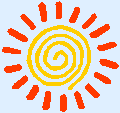| |
Chapter 5
Summary
Electric Circuit Puzzles
<Advance Preparation, review page 63>
<The Learning Cycle
Exploration scientific theory
Discovery electric circuit>
One Session (about 40 minutes)
1. Introducing the circuit puzzles
- Holding up your circuit tester, remind students of its function by touching the free
ends of the wires together. (The bulb should light.)
- Show students your puzzle folder and explain that you have arranged strips of foil
inside the card. Ask, “How could you discover how the foil is arranged without
looking inside the puzzle?” Solicit student suggestions for using the circuit
tester to identify possible connections between exposed dots of foil.
- When finished, ask, “How do you think the foil inside the puzzle is laid out?
What is your evidence?” After volunteers draw their solutions in the outlines you
put on the board, open the folder and reveal the actual foil pattern.
2. Setting up and testing circuit puzzles
- Distribute materials for assembling puzzles to each team.
- Student Journal page 12:
Students create their own circuit puzzles, exchange them
with their classmates, test the puzzles they receive using the circuit testers, and record
their inferences about the foil pattern of each on page 12.
- Finally, students open the puzzles and record the actual foil pattern in a different
color on page 12. (Each student should test four puzzles, starting with her own.)
3. Observing students’ ability to make inferences
- Informally evaluate your students’ ability to distinguish between inferences and
observations: they can observe which connections close the circuit, but must infer
where the foil is actually placed inside the closed folder.
- Step 3, page 65:
Ask yourself questions about how the students are working.
4. Setting up and investigating sealed puzzlesStudents remove the foil strips from their puzzles and use
them to construct a new puzzle in the same folder, recording their patterns on journal
page 13.
As in step 3, students exchange and test the puzzles, this time recording their
observations and inferences on page 13.
5. Discussing the differences between observation and inference
- Invite two or three volunteers who examined the same puzzle to draw their solutions on
the board.
- Ask each, “What evidence did you use to arrive at that solution to the puzzle?
What was your reasoning process?” Encourage students to discuss their tests,
reminding the puzzle creator to remain quiet about the actual arrangement for now.
- Ask, “What were you able to observe? What did you have to infer?
What do you think is the difference between observation and inference?”
- Solicit that observations are what we actually see (hear, feel, and so on). Inferences
are what we come up with to describe what happened to cause what we see. In the case of
the circuit puzzles, students observe which connections close the circuit but can
only infer the foil arrangement inside the folder.
- Scientific theories are based on inferences we make to explain what we cannot see. They
too are drawn from evidence we can see.
- Open the actual puzzles and compare them to the inference drawings on the board. Point
out that student inferences may correctly explain their observations even though they do
not reflect the actual arrangement of the foil pieces.
6. Identifying complete connected subsystems
- Define a complete connected subsystem as a piece or group of connected foil
pieces that are not connected to any other piece.
- Figure 5-1, page 63:
Point out that, in your demonstration puzzle, the set A, C, E
designates a complete connected subsystem. (The set A, E would be incomplete.)
- Challenge students to identify and name (e.g., Set A, B, D) complete connected
subsystems in their puzzles.
- Save the demonstration puzzle for use in Chapter 6. When students are finished
investigating their puzzles, remove the foil and tape and return them to the kit.
<Quick Check page 67>
Sarah Martin/Writing Sample/Delta
Education/Grade 6/TE
|
|

